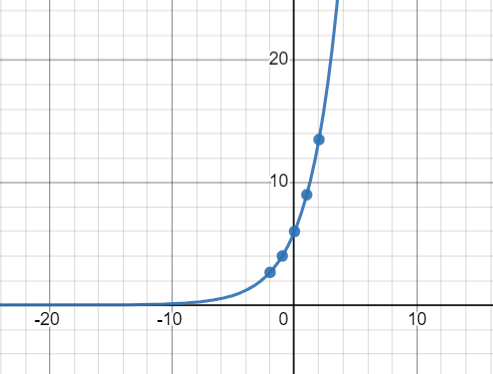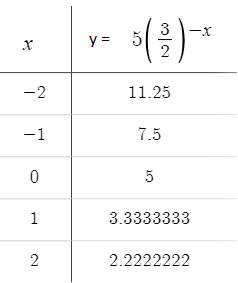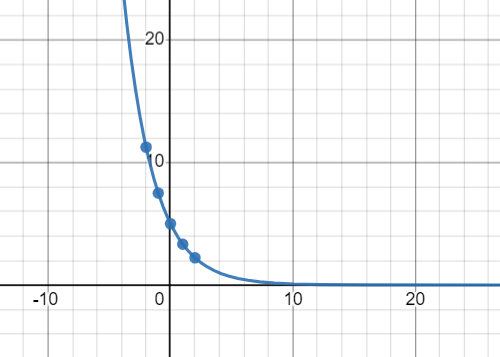Directions: Circle each function that is an example of exponential decay (there are exactly five of them). Graph each of these decay functions only. 1) f(x) = 2(4)* f(x) = 9-* f(x) = 6( ³ ) * f(x)=3(5)* (1(x) = (²7) 6 (3) = 2* f(x)=6 f(x)=2 211 201 TO 16 17 f(x)=5 f(x)=5 NW
Directions: Circle each function that is an example of exponential decay (there are exactly five of them). Graph each of these decay functions only. 1) f(x) = 2(4)* f(x) = 9-* f(x) = 6( ³ ) * f(x)=3(5)* (1(x) = (²7) 6 (3) = 2* f(x)=6 f(x)=2 211 201 TO 16 17 f(x)=5 f(x)=5 NW
Calculus: Early Transcendentals
8th Edition
ISBN:9781285741550
Author:James Stewart
Publisher:James Stewart
Chapter1: Functions And Models
Section: Chapter Questions
Problem 1RCC: (a) What is a function? What are its domain and range? (b) What is the graph of a function? (c) How...
Related questions
Question
can someone help me with this?
![### Transcription and Explanation for Educational Website
#### Problem 3:
**Function:**
\[ f(x) = \left(\frac{7}{2}\right)^{-x} \]
**Table of Values:**
| x | y |
|----|------------------------|
| -2 | \( \left(\frac{7}{2}\right)^{-2} = 12.25 \) |
| -1 | \( \left(\frac{7}{2}\right)^{-1} = 3.5 \) |
| 0 | \( \left(\frac{7}{2}\right)^{0} = 1 \) |
| 1 | \( \left(\frac{7}{2}\right)^{1} = 0.2 \) |
| 2 | \( \left(\frac{7}{2}\right)^{2} = 0.8 \) |
**Graph Description:**
The graph beside the table is a blank grid intended for plotting the function \( f(x) = \left(\frac{7}{2}\right)^{-x} \) as per the values in the table. The x-axis ranges from -3 to 3, and the y-axis from -9 to 9.
#### Problem 4:
**Function:**
\[ f(x) = 2\left(\frac{1}{4}\right)^{-x} \]
**Table of Values:**
| x | y |
|----|-----------------------|
| -2 | \( 2\left(\frac{1}{4}\right)^{-2} = 32 \) |
| -1 | \( 2\left(\frac{1}{4}\right)^{-1} = 8 \) |
| 0 | \( 2\left(\frac{1}{4}\right)^{0} = 2 \) |
| 1 | \( 2\left(\frac{1}{4}\right)^{1} = 0.5 \) |
| 2 | \( 2\left(\frac{1}{4}\right)^{2} = 0.125 \)|
**Graph Description:**
The graph beside the table is a blank grid intended for plotting the function \( f(x) = 2\left(\frac{1}{4}\right)](/v2/_next/image?url=https%3A%2F%2Fcontent.bartleby.com%2Fqna-images%2Fquestion%2F00c239b2-49f2-4118-83c1-4fc31b3c935a%2F8677940e-5838-4f7d-a06d-ded71dd092bb%2Fq9nd5g_processed.jpeg&w=3840&q=75)
Transcribed Image Text:### Transcription and Explanation for Educational Website
#### Problem 3:
**Function:**
\[ f(x) = \left(\frac{7}{2}\right)^{-x} \]
**Table of Values:**
| x | y |
|----|------------------------|
| -2 | \( \left(\frac{7}{2}\right)^{-2} = 12.25 \) |
| -1 | \( \left(\frac{7}{2}\right)^{-1} = 3.5 \) |
| 0 | \( \left(\frac{7}{2}\right)^{0} = 1 \) |
| 1 | \( \left(\frac{7}{2}\right)^{1} = 0.2 \) |
| 2 | \( \left(\frac{7}{2}\right)^{2} = 0.8 \) |
**Graph Description:**
The graph beside the table is a blank grid intended for plotting the function \( f(x) = \left(\frac{7}{2}\right)^{-x} \) as per the values in the table. The x-axis ranges from -3 to 3, and the y-axis from -9 to 9.
#### Problem 4:
**Function:**
\[ f(x) = 2\left(\frac{1}{4}\right)^{-x} \]
**Table of Values:**
| x | y |
|----|-----------------------|
| -2 | \( 2\left(\frac{1}{4}\right)^{-2} = 32 \) |
| -1 | \( 2\left(\frac{1}{4}\right)^{-1} = 8 \) |
| 0 | \( 2\left(\frac{1}{4}\right)^{0} = 2 \) |
| 1 | \( 2\left(\frac{1}{4}\right)^{1} = 0.5 \) |
| 2 | \( 2\left(\frac{1}{4}\right)^{2} = 0.125 \)|
**Graph Description:**
The graph beside the table is a blank grid intended for plotting the function \( f(x) = 2\left(\frac{1}{4}\right)

Transcribed Image Text:**Directions:**
Circle each function that is an example of exponential decay (there are exactly five of them). Graph each of these decay functions only.
Functions provided:
1. \( f(x) = 2 \left(4\right)^x \)
2. \( f(x) = 3 \left(5\right)^x \)
3. \( f(x) = 6 \left(\frac{2}{3}\right)^x \)
4. \( f(x) = 5 \left(\frac{3}{2}\right)^x \)
5. \( f(x) = 9^{-x} \)
6. \( f(x) = \left(\frac{7}{2}\right)^{-x} \)
7. \( f(x) = 2 \left(\frac{1}{4}\right)^x \)
8. \( f(x) = 5 \left(\frac{3}{7}\right)^x \)
Circled functions indicating exponential decay:
- \( f(x) = 6 \left(\frac{2}{3}\right)^x \)
- \( f(x) = 5 \left(\frac{3}{2}\right)^{-x} \)
- \( f(x) = 9^{-x} \)
- \( f(x) = \left(\frac{7}{2}\right)^{-x} \)
- \( f(x) = 2 \left(\frac{1}{4}\right)^x \)
**1) Function: \( f(x) = 6 \left(\frac{2}{3}\right)^x \)**
| x | \( y \) |
|----|-----------------------------|
| -2 | \( 6 \left(\frac{2}{3}\right)^{-2} = 13.5 \) |
| -1 | \( 6 \left(\frac{2}{3}\right)^{-1} = 9 \) |
| 0 | \( 6 \left(\frac{2}{3}\right)^0 = 6 \) |
| 1 | \( 6 \left(\frac{2}{3}\right)^1 = 4 \) |
| 2 | \( 6 \left(\frac{2}{3}\right)^2 = 2.6 \) |
- **Graph Description:**
Expert Solution
Step 1
As per the instruction, we will be answering the first three subparts.
For (a),

Graph:

For (b),

Graph:

Step by step
Solved in 2 steps with 6 images

Recommended textbooks for you

Calculus: Early Transcendentals
Calculus
ISBN:
9781285741550
Author:
James Stewart
Publisher:
Cengage Learning

Thomas' Calculus (14th Edition)
Calculus
ISBN:
9780134438986
Author:
Joel R. Hass, Christopher E. Heil, Maurice D. Weir
Publisher:
PEARSON

Calculus: Early Transcendentals (3rd Edition)
Calculus
ISBN:
9780134763644
Author:
William L. Briggs, Lyle Cochran, Bernard Gillett, Eric Schulz
Publisher:
PEARSON

Calculus: Early Transcendentals
Calculus
ISBN:
9781285741550
Author:
James Stewart
Publisher:
Cengage Learning

Thomas' Calculus (14th Edition)
Calculus
ISBN:
9780134438986
Author:
Joel R. Hass, Christopher E. Heil, Maurice D. Weir
Publisher:
PEARSON

Calculus: Early Transcendentals (3rd Edition)
Calculus
ISBN:
9780134763644
Author:
William L. Briggs, Lyle Cochran, Bernard Gillett, Eric Schulz
Publisher:
PEARSON

Calculus: Early Transcendentals
Calculus
ISBN:
9781319050740
Author:
Jon Rogawski, Colin Adams, Robert Franzosa
Publisher:
W. H. Freeman


Calculus: Early Transcendental Functions
Calculus
ISBN:
9781337552516
Author:
Ron Larson, Bruce H. Edwards
Publisher:
Cengage Learning